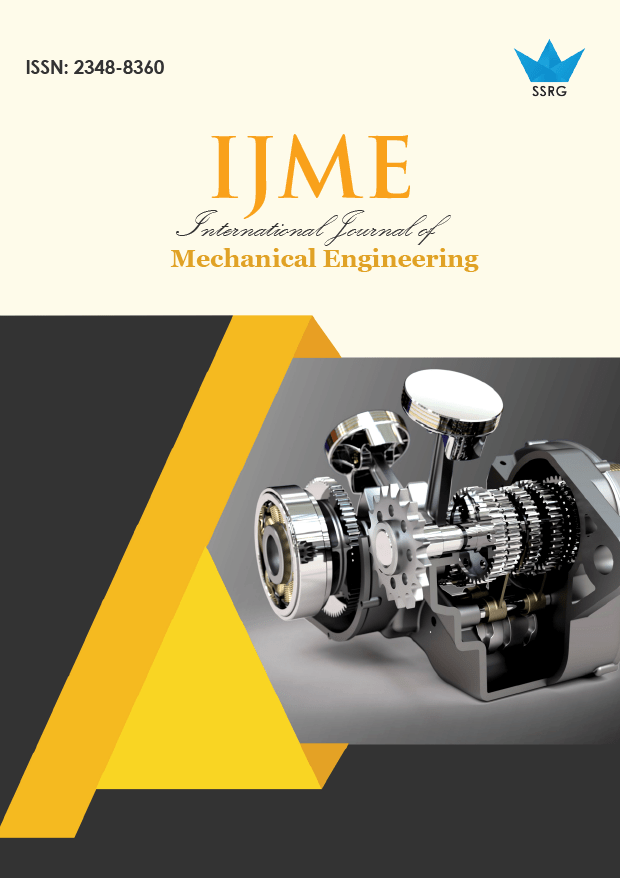Optimization of Layered Hybrid Laminates Using ANSYS for Enhanced Tensile Properties and Performance Analysis

| International Journal of Mechanical Engineering |
| © 2025 by SSRG - IJME Journal |
| Volume 12 Issue 1 |
| Year of Publication : 2025 |
| Authors : Ashish Apate, Sanjeev Kumar, Nitin H. Ambhore |
How to Cite?
Ashish Apate, Sanjeev Kumar, Nitin H. Ambhore, "Optimization of Layered Hybrid Laminates Using ANSYS for Enhanced Tensile Properties and Performance Analysis," SSRG International Journal of Mechanical Engineering, vol. 12, no. 1, pp. 99-112, 2025. Crossref, https://doi.org/10.14445/23488360/IJME-V12I1P112
Abstract:
This study examines the tensile properties of hybrid laminates through modelling analysis, focusing on Carbon Epoxy, Glass Epoxy, and Kevlar Epoxy composites. The laminates, each tested with a thickness of 2.5 mm for Carbon and Glass Epoxy and 2.5 mm for Kevlar Epoxy, were evaluated under a load of 100,000 Newtons using ANSYS 2024 R1 simulation software. The results obtained suggest that the Kevlar Epoxy possesses the highest degree of stiffness compared to the others. Then, a global comparative analysis of total strain, equivalent stress, normal stress, shear stress, equivalent elastic strain, normal elastic strain, and shear elastic strain is performed for Kevlar-reinforced carbon, glass, and aluminum composites. The result showed that aluminum-glass had the lowest deformations overall, and its value was 3.6849×10−4m, which was the greatest stiffness and minimum deformation under load. For equivalent stress, the Aluminum-Kevlar composite has the maximum stress or 1.62E+09 Pa, showing high durability. The maximum normal stress (9.22E+08Pa) together with maximum shear stress (2.27E+08Pa) capacity was found in the aluminium-glass composite which further proved resistance to both normal and tangential forces. The aluminum-carbon composite presents the maximum amount of elastic strain, meaning it has the largest deformation due to stress. Such significant work contributes greatly to understanding hybrid laminate mechanical performance: such knowledge about the material is important for selecting an appropriate material in engineering applications.
Keywords:
Hybrid laminates, Tensile properties, Total deformation, Equivalent stress, Elastic strain, Normal stress, Carbon epoxy, Kevlar-epoxy.
References:
[1] Dipen Kumar Rajak et al., “Recent Progress of Reinforcement Materials: A Comprehensive Overview of Composite Materials,”Journal of Materials Research and Technology, vol. 8, no. 6, pp. 6354-6374, 2019.
[CrossRef] [Google Scholar] [Publisher Link]
[2] Arun Kumar Sharma et al., “Matrix materials Used in Composites: A Comprehensive Study,” Materials Today: Proceedings, vol. 21, no. 3, pp. 1559-1562, 2020.
[CrossRef] [Google Scholar] [Publisher Link]
[3] S. Kangishwar et al., “A Comprehensive Review on Polymer Matrix Composites: Material Selection, Fabrication, and Application,” Polymer Bulletin, vol. 80, pp. 47-87, 2023.
[CrossRef] [Google Scholar] [Publisher Link]
[4] Bisma Parveez et al., “Scientific Advancements in Composite Materials for Aircraft Applications: A Review,” Polymers, vol. 14, no. 22, pp. 1-32, 2022.
[CrossRef] [Google Scholar] [Publisher Link]
[5] Jolie Frketic, Tarik Dickens, and Subramanian Ramakrishnan, “Automated Manufacturing and Processing of Fiber-Reinforced Polymer (FRP) Composites: An Additive Review of Contemporary and Modern Techniques for Advanced Materials Manufacturing,” Additive Manufacturing, vol. 14, pp. 69-86, 2017.
[CrossRef] [Google Scholar] [Publisher Link]
[6] Israel O. Ayodele et al., “Characterization of Steered Fiber Laminates: Perspectives and a Survey of the State of the Art on Principal Considerations,” Composites Part C: Open Access, vol. 4, pp. 1-10, 2021.
[CrossRef] [Google Scholar] [Publisher Link]
[7] Swaroop B. Visweswaraiah, Larry Lessard, and Pascal Hubert, “Tensile Behaviour of Hybrid Fibre Architectures of Randomly Oriented Strands Combined with Laminate Groups,” Journal of Composite Materials, vol. 53, no. 26-27, pp. 3725-3740, 2019.
[CrossRef] [Google Scholar] [Publisher Link]
[8] David Broadhurst et al., “Guidelines and Considerations for the Use of System Suitability and Quality Control Samples in Mass Spectrometry Assays Applied in Untargeted Clinical Metabolomic Studies,” Metabolomics, vol. 14, pp. 1-17, 2018.
[CrossRef] [Google Scholar] [Publisher Link]
[9] K. Mohamed Kaleemulla, and B. Siddeswarappa, “Influence of Fiber Orientation on the In-Plane Mechanical Properties of Laminated Hybrid Polymer Composite,” Journal of Reinforced Plastics and Composites, vol. 29, no. 12, pp. 1900-1914, 2010.
[CrossRef] [Google Scholar] [Publisher Link]
[10] Srinivasa D. Thoppul, Joana Finegan, and Ronald F. Gibson, “Mechanics of Mechanically Fastened Joints in Polymer–Matrix Composite Structures: A Review,” Composites Science and Technology, vol. 69, no. 3-4, pp. 301-329, 2009.
[CrossRef] [Google Scholar] [Publisher Link]
[11] Lothar Wondraczek et al., “Advancing the Mechanical Performance of Glasses: Perspectives and Challenges,” Advanced Materials, vol. 34, no. 14, pp. 1-25, 2022.
[CrossRef] [Google Scholar] [Publisher Link]
[12] Subrata C. Das et al., “Effect of Stacking Sequence on the Performance of Hybrid Natural/Synthetic Fiber Reinforced Polymer Composite Laminates,” Composite Structures, vol. 276, pp. 1-8, 2021.
[CrossRef] [Google Scholar] [Publisher Link]
[13] Guangyong Sun et al., “On the Effects of Temperature on Tensile Behavior of Carbon Fiber Reinforced Epoxy Laminates,” Thin-Walled Structures, vol. 164, 2021.
[CrossRef] [Google Scholar] [Publisher Link]
[14] Ramesh Kumpati, Wojciech Skarka, and Sunith Kumar Ontipuli, “Current Trends in Integration of Nondestructive Testing Methods for Engineered Materials Testing,” Sensors, vol. 21, no. 18, pp. 1-32, 2021.
[CrossRef] [Google Scholar] [Publisher Link]
[15] V. Infante et al., “Characterization and Optimization of Hybrid Carbon–Glass Epoxy Composites under Combined Loading,” Journal of Composite Materials, vol. 53, no. 18, pp. 2593-2605, 2019.
[CrossRef] [Google Scholar] [Publisher Link]
[16] Silu Huang, “Characterization of Interfacial Properties between Fibre and Polymer Matrix in Composite Materials – A Critical Review,” Journal of Materials Research and Technology, vol. 13, pp. 1441-1484, 2021.
[CrossRef] [Google Scholar] [Publisher Link]
[17] Mitesh Patadia, and Rebekah Sweat, “Modelling and Analysis of Multiscale Hybrid Composite Structures for Virtual Design and Performance-Driven Manufacturing: A Review,” Advanced Materials and Processing Technologies, pp. 1-36, 2024.
[CrossRef] [Google Scholar] [Publisher Link]
[18] M. Damghani et al., “An Experimental Investigation of Tensile Residual Strength of Repaired Composite Laminates after Low Velocity Impact,” Thin-Walled Structures, vol. 200, pp. 1-20, 2024.
[CrossRef] [Google Scholar] [Publisher Link]
[19] Kishan Pal Singh, and Asim Ahmad, “Investigating Tensile Properties of Hybrid Laminates,” International Journal of Mechanical Engineering, vol. 6, pp. 304-307, 2021.
[Google Scholar] [Publisher Link]
[20] Mahdi Damghani et al., “An Experimental Investigation of the Impact Response and Post-Impact Shear Buckling Behaviour of Hybrid Composite Laminates,” Composite Structures, vol. 305, pp. 1-13, 2023.
[CrossRef] [Google Scholar] [Publisher Link]
[21] Suhad D. Salman, “Partial Replacement of Synthetic Fibres by Natural Fibres in Hybrid Composites and its Effect on Monotonic Properties,” Journal of Industrial Textiles, vol. 51, no. 2, pp. 258-276, 2021.
[CrossRef] [Google Scholar] [Publisher Link]
[22] Sun Guangyong et al., “Mechanical Properties of Hybrid Composites Reinforced by Carbon and Basalt Fibers,” International Journal of Mechanical Sciences, vol. 148, pp. 636-651, 2018.
[CrossRef] [Google Scholar] [Publisher Link]
[23] K.G. Satish, B. Siddeswarappa, and K. Mohamed Kaleemulla, “Characterization of In-Plane Mechanical Properties of Laminated Hybrid Composites,” Journal of Minerals and Materials Characterization and Engineering, vol. 9, no. 2, pp. 105-114, 2010.
[CrossRef] [Google Scholar] [Publisher Link]
[24] Jun Hee Song, “Pairing Effect and Tensile Properties of Laminated High-Performance Hybrid Composites Prepared Using Carbon/Glass and Carbon/Aramid Fibers,” Composites Part B: Engineering, vol. 79, pp. 61-66, 2015.
[CrossRef] [Google Scholar] [Publisher Link]
[25] H.P.S. Abdul Khalil, M. Jawaid and A. Abu Bakar, “Woven Hybrid Composites: Water Absorption and Thickness Swelling Behaviours,” BioResources, vol. 6 , no. 2, pp. 1043-1052, 2011.
[CrossRef] [Google Scholar] [Publisher Link]
[26] R. Murugan, R. Ramesh, and K. Padmanabhan, “Investigation on Static and Dynamic Mechanical Properties of Epoxy-Based Woven Fabric Glass/Carbon Hybrid Composite Laminates,” Procedia Engineering, vol. 97, pp. 459-468, 2014.
[CrossRef] [Google Scholar] [Publisher Link]

 10.14445/23488360/IJME-V12I1P112
10.14445/23488360/IJME-V12I1P112